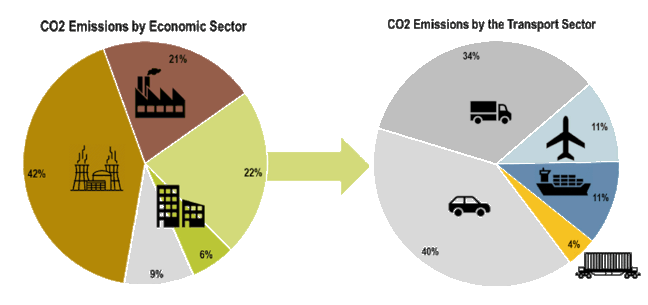WANDERLUST
SUSTAINABLE TRAVEL
To be fair, the headline is self-contradictory as sustainable travelling is non-existent. Tourism contributes up to 8 % of global greenhouse gas emissions, and most of it is from travelling. Global warming awareness seems to have had two completely opposite responses in my circle of acquaintances. Apathy vs. Activism. The consequences either seem so comprehensive and overwhelming that people tend to give up trying to do anything about it and simply just go on travelling exactly like they did before. Or, diametrically opposed, they stop travelling altogether, at least by plane. The term ‘climate shame’ weighs heavily.
However, as the chart above indicates, there are other things than changing your travel habits you should do in order to reduce your carbon footprint (Source:
International Energy Association. IEA and IPCC, 2014). Make some changes in your everyday life regarding consumption of energy, food and clothes. E.g. adjusting the temperature so you use less energy to heat or cool down your homes. Commuting by foot, bike or public transportation instead of using a car. Reduce the use of power tools in your home, etc. Eating less meat. Not buying clothes and other consumer goods as often as you used to, and when you do, buy better quality so it’ll last longer. Buy locally produced goods. The short mantra is: Reduce, Reuse, Recycle. There are many resources where guidelines and advice about this can be found. You can start right now by changing your default search engine to Ecosia.
On this page I’ll concentrate on what you can do in relation to travelling. While waiting for the technology to make air travel less damaging, all travelers can do something by choosing less polluting options in order to cause a lower carbon footprint. No raised fingers, just ideas you may consider.
GETTING THERE
TRAIN: Go by train, if you can. If you go the same distance by train instead of by plane, you will reduce carbon emissions by 90 per cent. For shorter distances, e.g. Copenhagen to Stockholm, it doesn’t necessarily take longer due to check-in time ahead of flights, travel distances to and from the airports, etc. Other benefits are than you’ll usually have more space, you can get up and move around, and you’ll see the country you travel through.
PLANE: The obvious advice is: Stop flying! For those of us who have the travel bug, this is easier said than done. But at least you can fly less.
Fly direct if you can. Taking off and landing uses a high proportion of fuel compared to the rest of the flight. And a stop-over often means a deviated and longer route.
Fly less mileage. Lots of great holiday adventures can be found closer to where you live, and you may not even have to fly (every time).
Fly new planes. The latest planes offer better fuel efficiency.
Travel lightly. Your carbon footprint is heavier the heavier you travel. Don’t be tempted to pack 20 kg just because you can. Only bring what you need.
Time of day or year. The plane’s condensation trail (water vapour and engine exhaust) has an effect on the carbon footprint. It is worse at night and during cold weather.
Don’t fly. Business class means more space per seat, i.e. more energy is consumed. Does that business meeting really have to be in person or could it be done digitally? Several VR business environments offer this service.
Carbon offsetting, aka carbon sequestration. It is important to remember that offsetting does not reduce emissions. But it may reduce your ‘climate shame’. It is of course better to plant new forests than not doing anything at all. But preventing deforestation is better than reforestation. If you choose this option, make sure to choose one of the well-reputed organizations. A good place to start could be Atmosfair.
GETTING AROUND
Use public transport instead of taxis. Especially if you are the adventurous kind. I’ll never forget the ride on a local bus in the Gambia, where people brought anything from building materials to live chicken in cages.
Excursions: Hiking, biking, canoeing, rafting or horseback riding instead of guided bus tours, jeep safaris, ATVs, motorboating, jetskiing, etc.
ACCOMODATION
There are many parameters to consider when lowering the impact of your accomodation. Do they use fossil fuels or renewable energy sources? Do they use energy saving appliances and automatic switch-off? Do they serve locally produced food? Do they hire local staff? And a zillion other things to consider. Much too overwhelming for the average traveller to familiarize himself with. Instead, you could look for international ecolabels such as Bio Hotels or Green Key.
FOOD
Buy locally produced food instead of food which needs to be transported over long distances. Besides this, you will support local business, and for me experiencing local food is part of the great experience of travelling.
Eat less processed food to reduce the energy comsumption.
Eat less meat and more plant-based food in order to reduce carbon emissions from meat farming. Not to mention the deforestation which is linked to this in some areas of the world.
Avoid imported bottled water. If your stomach is anything like mine, you'll need bottled water in many parts of the world. But buy a local brand instead of the imported French brand. (If you have good quality drinking water at home you may consider not buying bottled water at all where you live).
SHOPPING
Buy local. Buy from a local retailer instead of a large international chain. Buy local products instead of imported. I bought a silk scarf in Bukhara from a local weaver in order to make sure it was locally produced in Uzbekistan. In the market, almost all the silk scarfs were imported from China and sold at roughly the same price as the locally produced.
WHAT ELSE CAN I DO?
Visit the Ecolabel Index for other ideas for a more sustainable way of travelling.
© emenel 2020




